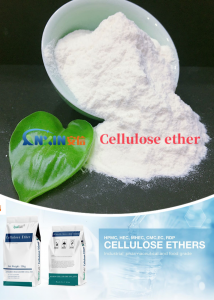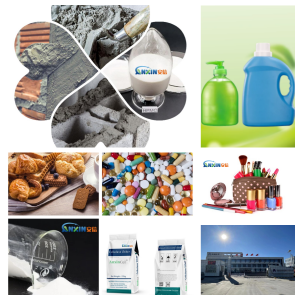Cellulose ethers are a class of water-soluble polymer derivatives derived from chemically modified natural cellulose. Common varieties include hydroxypropyl methylcellulose (HPMC), methylcellulose (MC), hydroxyethylcellulose (HEC), carboxymethylcellulose (CMC), and methylhydroxyethylcellulose (MHEC). They combine the safety of natural cellulose with the excellent physical and chemical properties of modified cellulose. They excel in thickening, water retention, film formation, bonding, dispersion, emulsification, and suspension. Therefore, they are widely used in industries such as construction, pharmaceuticals, food, daily chemicals, petroleum, papermaking, and coatings.
1. Construction and Building Materials Industry
Construction is the largest application market for cellulose ethers, particularly in materials such as dry-mix mortar, tile adhesives, putty powder, self-leveling, cement mortar, and gypsum products.
Water Retention: In cement- and gypsum-based materials, cellulose ethers can effectively slow water evaporation, ensuring full hydration of the cementitious material and improving its strength. Improved Workability: Enhances the lubricity and thixotropy of mortar, facilitating smoothing and extending workability.
Prevents Cracking and Hollowing: Evenly releases moisture, reducing shrinkage cracks caused by rapid water loss.
Improves Adhesion: Improves adhesion to the substrate or tile, enhancing overall durability.
For example, while HPMC and MHEC are used in tile adhesives and insulation mortars at low dosages (0.2%-0.7%), they can significantly enhance workability, making them indispensable additives for modern building materials.
2. Pharmaceutical Industry
Cellulose ethers are important pharmaceutical excipients, meeting pharmacopoeial standards and demonstrating safety, non-toxicity, and excellent biocompatibility.
Tablet Coating and Controlled-Release Materials: HPMC is commonly used as a film coating for tablets, masking the drug’s flavor while also enabling sustained and controlled release.
Capsule Shell Materials: HPMC capsules, as a gelatin substitute, are animal-free, offer excellent stability, and are suitable for vegetarians and individuals with special religious beliefs. Tablet Binders and Disintegrants: CMC-Na, HPMC, and others can improve the mechanical strength of tablets and promote rapid dispersibility in the body.
Eye Drop Thickeners: HEC and HPMC are used in artificial tears to lubricate the eye and prolong drug retention.
3. Food Industry
CMC, MC, and HPMC are the most widely used food-grade cellulose ethers, providing thickening, emulsification, stabilization, and moisturizing properties.
Thickening and Stabilizing Agents: Used in ice cream, yogurt, and fruit juice drinks to prevent crystallization or separation.
Low-Calorie Substitutes: Used as a fat substitute to improve taste and reduce calorie intake.
Bakery Products: HPMC improves dough structure, enhances water retention, and increases fluffiness in bread and cakes.
Preservatives and Film-Forming Agents: Forms an edible film on fruit, extending shelf life.
4. Daily Chemicals and Personal Care Products
Cellulose ethers provide stabilization and texture-modifying properties in detergents, cosmetics, and skincare products. Thickening and suspending agents: HEC is commonly used in shampoos and body washes to achieve the desired consistency and stabilize fragrances and suspended particles.
Moisturizing ingredients: HPMC and CMC form a moisturizing film on the skin surface, preventing water loss.
Emulsion stabilization: It acts as an emulsion stabilizer in creams and lotions.
Toothpaste base: CMC-Na is used as a binder and thickener in toothpaste, imparting a pleasant feel and smoothness.
5. Oil and Gas Extraction
Cellulose ethers also have important applications in drilling fluids and oil recovery processes.
Fluid loss control agents: CMC and PAC (modified carboxymethyl cellulose) can reduce fluid loss in drilling fluids and protect oil and gas formations.
Rheology modifiers: They improve drilling fluid viscosity and flowability, facilitating the transport of drill cuttings.
Stabilizers: They maintain good solubility and stability in high-salt and high-temperature environments.
6. Coatings and Paints Industry
HEC and HPMC are important additives for water-based coatings. Thickeners: Adjust paint viscosity and improve brush and roller application.
Leveling and Anti-Sagging: Control coating fluidity and prevent film sagging.
Dispersants: Help evenly disperse pigments and fillers, enhancing color vividness and stability.
Water Retention and Film Formation: Slows drying, forms a uniform paint film, and improves scrub resistance.
7. Papermaking and Textile Industry
Cellulose ethers are also important additives in papermaking and textile processes.
Paper Sizing Agent and Surface Enhancer: CMC improves paper strength, smoothness, and oil resistance.
Dyeing Thickeners: CMC and HEC are used in textile printing pastes to provide good rheological properties and color uniformity.
Fiber Sizing Agents: Improve yarn strength and abrasion resistance, reducing yarn breakage.
8. Other Industrial Fields
Ceramic Industry: HPMC is used for thickening, water retention, and bonding in ceramic bodies and glazes.
Adhesives: Cellulose ethers can be combined with polymers to enhance adhesive performance. Agriculture: Used as a coating material for pesticide suspensions and slow-release fertilizers, improving application efficiency.
Daily Chemicals: Used as a suspending and film-forming agent in detergents and air fresheners.
Cellulose ethers, thanks to their water solubility, non-toxicity, stability, and diverse functionality, have penetrated nearly every industry. From construction and building materials to pharmaceuticals and food, from daily chemicals to petroleum-based paints, they can be found. Their greatest value lies in their low usage and significant effectiveness, enhancing product performance by improving rheology, water retention, film formation, and dispersibility. With the growing demand for green, environmentally friendly, and high-performance materials, the application areas of cellulose ethers will continue to expand, playing an even more important role in future industrial development.
Post time: Sep-05-2025

